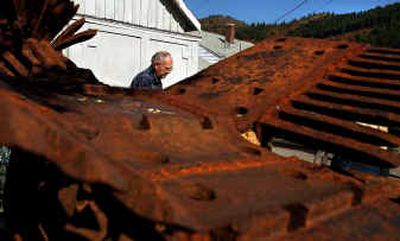Not the end of the line

KELLOGG — The quest to create something beautiful didn’t motivate Marvin Lake to pick up the rusty rail spikes littering the gravel road near his weekend trailer along the St. Joe River.
Lake, the son of a logger, knew what the sharp sticks of iron could do to the tires of log trucks. He and his wife, Janet, do a lot of walking on the abandoned Milwaukee Road line, and they eventually amassed small piles of the old rail spikes.
“I thought, ‘There’s gotta be something I can do with those,’ ” Marvin Lake said.
Nearly a century after the spikes were used to anchor a transcontinental shipping line, they are being reborn as sculpture. Lake, a 70-year-old retiree, can’t really put into words why he began welding the spikes into fantastical dragonflies, roadrunners and historical dioramas.
“I just need to be making something all the time,” Lake said on a recent afternoon while showing off his creations at his Kellogg home. “I just can’t sit. I just can’t sit.”
None of the sculptures is for sale. All Lake hopes for is a safe place to publicly display his rail art. “I don’t know that anybody would want to buy them. I really don’t do this stuff for pay.”
Lake doesn’t hide his art – one of the larger sculptures is on open display in the dirt alley behind his home – but he’s hardly a self-promoter. If people are interested, so be it, he said.
Apart from a constant desire to keep busy, Lake said he sees his art as part of his dues for citizenship.
Lake has lived his lifetime in the Silver Valley, raising three sons and working at a variety of jobs – truck driver, tire repairman, cable and satellite television network installer. He has a strong sense of civic pride and volunteers for a variety of groups and governmental boards. Not long ago, he and his wife planted 130 acorns along a local public trail. A year later, 114 oaks sprouted, and the couple watered the seedlings through the heat of the summer.
Sculptures made of historic metal are just one other way for Lake to enhance his surroundings.
“There’s no end. Every time I look around, there’s something else that could be done,” Lake said. “There’s a billion things people can do. I get so mad when I see these people just sitting watching TV.”
Even though the rusted rail spikes might be considered junk, Lake considers them historic junk. The Chicago, Milwaukee, St. Paul and Pacific Railroad, known as the Milwaukee Road, was punched through the St. Joe Valley at the turn of the 20th century. Men died laying the rails and digging the tunnels. But the railroad played an important role in shipping grain, automobiles and even war munitions for a growing nation.
By the late 1970s, the railroad’s finances and hardware were in shambles. In 1977, the year the Milwaukee Road went bankrupt, the mainline through Montana was averaging a derailment per day. The situation wasn’t much better in Idaho, Lake said.
A gravel road now covers the old rail bed. Whenever the road is graded – usually twice a year – new pieces of metal are unearthed. Lake gathers brake shoes, creepers, fish plates and many pieces he can’t identify. The metal is covered with a patina of rust and mud, which is ground away in a cement mixer filled with gravel.
One of Lake’s sculptures, a miniature locomotive and log cars built out of spikes, rests atop a jagged piece of rail. “That probably caused a derailment,” he said, pointing to the torn ends of the rail. The sculpture is the only one currently on display publicly. It can be seen at the Historic Silver Valley Chamber of Commerce visitor center in downtown Kellogg.
Resting on boards behind Lake’s home is a large metal bird with a coil spring neck. The bird, titled “The Milwaukee Roadrunner,” weighs an estimated 900 pounds. Soldiers made out of spikes strut under its rusted wings. Lake doesn’t recall how many hours it took to weld the hundreds of spikes and plates together. Why keep track? He also doesn’t talk about the piece in abstract, big-city artist language. He didn’t “give birth” to the piece or spend a lot of time conceptualizing it.
“I couldn’t draw a straight line if I didn’t have a ruler,” Lake said.